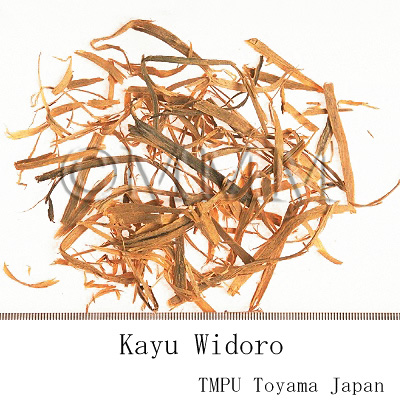Crude drug sample data base
※Click on the image to enlarge it.
Scientific information data base
| Crude drug name | Indonesian name, English name | Bidara laut | ||||
|---|---|---|---|---|---|---|
| Synonyms | Kayu ular, Bidara pait, Bidara putih | |||||
| crude drug image |
| |||||
| Original plant name | Strychnos ligustrina Blume | |||||
| Family name | Loganiaceae | |||||
| Used part | Bark, wood, roots | |||||
| Distribution area | It occurs in eastern Java, the Lesser Sunda Islands, the southern Moluccas [205]. It occurs in teak forest and other dryland forest, scrubs and savannas, up to 200 or 400 m altitude [201, 205]. | |||||
| Description | The wood is strong, hard and yellow in colour. The plant is a shrub or small deciduous tree up to 12 m tall, bole often crooked and up to 25 cm in diameter, spiny when young, branches densely and finely lenticellate, grey. Leaves ovate or elliptical to suborbicular. Inflorescence terminal with 10-flowered. Fruit globose, 2-3 seeded. Seeds are nearly disk-shaped, densely short pubescent. All parts of the plants are bitter. Fruits and roots are the most bitter parts of the plant [201, 205]. | |||||
| Drug effect | Bitter, cooling, blood cleanser, improving blood circulation, poisonous [231]. | |||||
| Specific actions | Anti-inflammatory, analgesic, diaphoretic [231]. | |||||
| Frequency in use | Moderate. | |||||
| Side effect | In general, all preparations containing Strychnos should be used in small doses and with great caution because of their toxicity [205]. Strychnine is a very toxic alkaloid with a lethal dose starts at about 0.4 mg / kg. In small doses it produces excitation of all parts of the central nervous system. Brucine is less active as a poison [205]. | |||||
| Pharmacological effect | Aqueous and ethanolic extracts of Strychnos leaves showed antifungal activity against several pathogens of rice in India [205]. Result of a test for the mechanism-based inhibition on cytochrome P 450 3A4 and CYP2D6 of S. ligustrina wood showed more than 30% increase of CYP 3A4 inhibition [PMID: 16414224]. | |||||
| Medical system | Indonesian medicine (Jamu) | |||||
| Traditional usage | Bark, wood, roots are used in Indonesian traditional medicine to treat fever, snake bites, sores, wounds, eczema, as stomachic and vermifuge. Decoction of the wood is used as a blood purifier and is drunk to cure sores, abscess, acne. In treating fever, wood is steeped in water to make a tea and drunk the tea to sweat. A combination of the wood with turmeric and fruit of Helicteres isora is steeped in water to make a tea and the tea is drunk for stomach problems. Wood is steeped in water and used externally for skin diseases, as an anthelmintics and in treating smallpox [201, 205]. | |||||
| Formulation | 1) Scabies, boils, skin inflammation with pus: 500 mg of woods of S. ligustrina, 3 grams of leaves of Cassia alata, 4 grams of rhizome of turmeric are mixed and boiled with 110 ml of water to make a decoction. Use the decoction as a compress in the affected areas, renew after every 3 hours [231]. 2) Rheumatism: 100 mg of wood of S. ligustrina, 8 grams of leaves of Anacardium occidentale, 2 grams of seed of Apium graveolens are boiled with 100 ml of water to make a decoction. Drink 100 ml of the decoction once a day for 14 days [231]. | |||||
| References | Reference book Tips! | [201] K. Heyne, Tumbuhan Berguna Indonesia, Vols. 1-4, 1987. Diedarkan Oleh Koperasi Karyawan Departemen Kehutanan, Jakarta, Indonesia. Vol. 3, pp 1615-1616. [205] de Pdua, L.S., Bunyapraphatsara, N. and Lemmens, R.H.M.J. (Editors), 1990. Plant Resources of South-East Asia No. 12 (1). Medicinal and poisonous plants 1. Backhuys Publishers, Leiden, Netherlands. pp 467-471. [231] Soedibyo, Mooryati: Alam Sumber Kesehatan: Manfaat dan Kegunaan (Natural resources for health. Benefits and uses). Balai Pustaka. 1998. pp 86-87. | ||||
| Research paper | 1. Subehan, Usia T, Iwata H, Kadota S, Tezuka Y. Mechanism-based inhibition of CYP3A4 and CYP2D6 by Indonesian medicinal plants. J Ethnopharmacol. 24;105(3):449-55, 2006. (PMID: 16414224) | |||||
| Remarks | Strychnos has been used as an ingredient in tonic preparations, but it is no longer used in modern therapy [205]. Strychnos has been used medicinally in China since the 14th century. | |||||
| Last renewal date | 2024/02/29 | |||||





